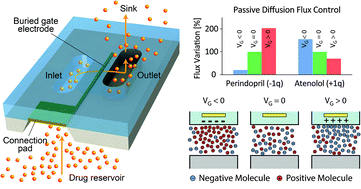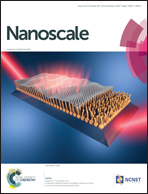The active modulation of drug release by an ionic field effect transistor for an ultra-low power implantable nanofluidic system†
Abstract
We report an electro-nanofluidic membrane for tunable, ultra-low power drug delivery employing an ionic field effect transistor. Therapeutic release from a drug reservoir was successfully modulated, with high energy efficiency, by actively adjusting the surface charge of slit-nanochannels 50, 110, and 160 nm in size, by the polarization of a buried gate electrode and the consequent variation of the electrical double layer in the nanochannel. We demonstrated control over the transport of ionic species, including two relevant hypertension drugs, atenolol and perindopril, that could benefit from such modulation. By leveraging concentration-driven diffusion, we achieve a 2 to 3 order of magnitude reduction in power consumption as compared to other electrokinetic phenomena. The application of a small gate potential (±5 V) in close proximity (150 nm) of 50 nm nanochannels generated a sufficiently strong electric field, which doubled or blocked the ionic flux depending on the polarity of the voltage applied. These compelling findings can lead to next generation, more reliable, smaller, and longer lasting drug delivery implants with ultra-low power consumption.



 Please wait while we load your content...
Please wait while we load your content...